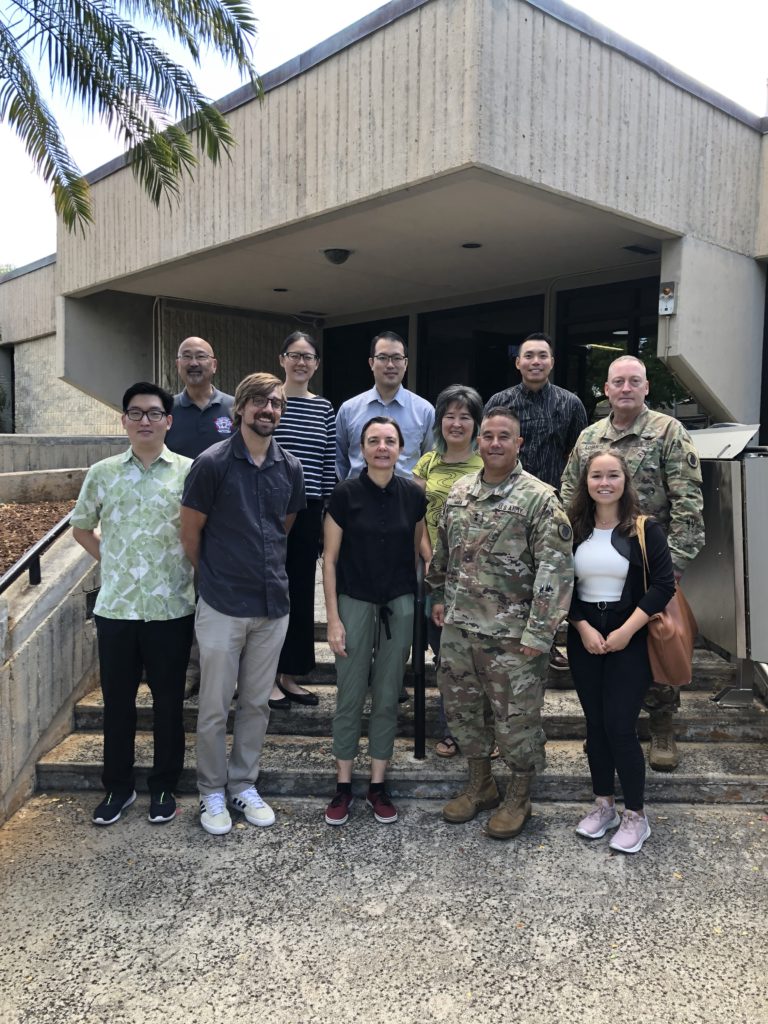Born Out of Necessity
AS COVID-19 CASES WERE RAPIDLY ESCALATING IN 2020, a group of University of Hawai‘i (UH) faculty and students were gathering behind the scenes, feverishly working on a new collaborative effort that would help to understand the trajectory of the pandemic in Hawai‘i and therefore control it better.
“In the beginning, there was so much confusion,” said Victoria Fan, director of Pacific Health Analytics Collaborative and associate professor of health policy at the University of Hawai‘i at Mānoa (UH Mānoa). “Evolving science of a new disease and confusing numbers and data offered limited explanation as to what all this constantly changing information meant for families, communities, or public policy.”
COVID-19 specific models, whose primary goals are to extract and provide meaningful insights from data including possible scenarios depending on non-pharmaceutical interventions as well as forecasts and predictions, started to be developed and used around the world. These models helped to analyze data and help to predict the potential impact of certain policy decisions, as well as forecast and predict COVID case counts and hospitalizations to help countries better respond and prepare for spikes in cases and healthcare needs.
“We were monitoring national and international models, but none were directly relevant to Hawai‘i, and yet these national models —some without accurate Hawai‘i data — were impacting major policy decisions and actions of our community,” added Fan, who founded and has chaired the Hawai‘i Pandemic Applied Modeling (HiPAM) — a volunteer working group of applied epidemiologists, data scientists, health workers and professionals committed to adapting tools to inform data-driven decision making and planning since April of 2020.
A Quiet and Humble Start
HiPAM started in 2020 behind the scenes. One of those early models had predicted that Hawai‘i would be hit with a surge that would require additional healthcare capacity. That opened up a debate about retrofitting the Hawai‘i Convention Center to serve as an acute care facility. The state Hawai‘i Emergency Management Agency (HI-EMA) assigned Thomas Lee as lead epidemiologic adviser and gave him just a few hours to advise whether or not it was necessary.

Having adapted a national epidemiologic data model using local data, Lee was able to forecast that Hawai‘i would not see a major surge and did not require retrofitting a stadium for an acute care facility. With no immediate surge in May of 2020, the state was able to save millions in funding that was diverted for use on other important COVID-19 efforts.
Not long after, HiPAM launched its ongoing two-week COVID-19 forecast on its website in July of 2020. After that, there were several cases where HiPAM’s forecasts were used for informing decisions, initially behind the scenes to policymakers in 2020 and later shared directly to the public from 2021 onwards. At each juncture and surge of the epidemic, HiPAM earned credibility through the accuracy of its forecast, buttressed by a brain trust and technical advisory group that helped to properly and nimbly build, interpret, understand, and use COVID-19 models throughout Hawai‘i’s pandemic.
“HiPAM’s accurate estimates allowed the state to be proactive rather than reactive, resulting in reduced deaths and human suffering,” said Major General Kenneth Hara, director of HI-EMA and the state’s incident commander for COVID-19 pandemic response. “Their efforts, especially their modeling products, were invaluable when making decisions and policy recommendations. Their team of experts and professionals continuously demonstrated flexibility and the desire to improve their modeling methodology and products.”
Becoming a Trusted Voice
HiPAM focused on being accurate and trustworthy, nimble and timely. Unlike other models being developed on the mainland and abroad, the HiPAM model delivered ongoing two-week forecasts versus the more common, multi-month forecasts, which would become obsolete within weeks due to ever-changing data, government policies, human behavior and other factors. Rather than get embroiled in tense political discourse, HiPAM emphasized the communication of an unbiased forecast without advocating a policy recommendation. Rather, HiPAM repeatedly emphasized that forecasts are just one piece of information that policymakers and the public need to make decisions.

By 2021, a model developed by UH Mānoa Department of Mathematics Professor Monique Chyba and her students allowed HiPAM to refine its statewide forecasts based on Hawai‘i’s unique demographic, geography, culture and industry impact, eventually leading to county-specific forecasts as well.
“We learned mitigation measures should be really targeted and localized to be more effective, not just for the state but for each county,” said Lee, HiPAM co-chair. “Having HiPAM members from across the UH System and other organizations really helped us to develop a Hawai‘i specific, more holistic model and approach.”
Fan and Lee noted some of the invaluable contributions made by members of this multi-disciplinary group. Chyba and other UH faculty improved the modeling, Marguerite Butler of UH Mānoa’s Department of Biology helped the team to better understand how disease testing lineages and mutations could potentially affect the data, and those from neighbor islands like UH Maui College STEM faculty Tom Blamey and Kaua‘i District Health Officer Janet Berreman provided important perspectives on their respective county’s situations and needs. Istvan Szapudi and Lee Altenberg from astronomy and computer science had mathematical insights about COVID’s unique spread, such as its superspreading aspect. Community partners such as Hawai‘i Health Information Exchange (Francis Chan), Queen’s Medical Center (Roy Esaki and Kiyoshi Shiraishi), and Hawaii Medical Service Association (Brian Wu), and others were regular HiPAM contributors and members.
“No one expert or authority could presume to have complete expertise,” said Fan, when discussing the HiPAM’s diverse background — academics and professionals in epidemiology, data science, computer science, mathematics, health care, and aging.
She added, “With a new disease, we all learned from each other. It was amazing to see the brilliance of the team. It really showcased the wealth of knowledge the University of Hawai‘i has to offer. We were able to de-silo systems and protocols — bring together different fields and industries, share information, skills and expertise — and just get things done.”
HiPAM demonstrates that UH is able to play a gap-filling role in using our expertise and sharing science and knowledge in a way that directly benefits the community.
– Victoria Fan
Other countries also benefited from their own pandemic modeling advisory group — Ireland, the United Kingdom, Australia, among others. Hawai‘i is notable for having its own modeling expertise within the state despite its smaller size.
Workforce Development
“One of the biggest milestones of HiPAM was the workforce training opportunities for our students,” said Chyba, who at any given time had up to 10 undergraduate and graduate students working on refining the modeling. “There are few opportunities for pure mathematics programs to engage in actual, concrete and timely challenges, and our students played a major role in these efforts.”
HiPAM’s success in showcasing the impact and real-world application of mathematics reinforces the need for UH Mānoa College of Natural Sciences’ newly developed tracks. Both its mathematics and information and computer sciences departments have implemented data sciences tracks, and the mathematics department is implementing a new computational science track in Fall 2022. These new tracks are focused on helping students develop desirable skills that can be applied to other industries and government organizations, and grow data-driven careers in Hawai‘i.
The Future
While the COVID-19 pandemic has been downgraded to an endemic status, the virus is still prevalent and many long-term issues magnified by the crisis remain, including substance abuse, mental health, aging, and unemployment. Additionally, it has been suggested that more pandemics are on the horizon due to the effects and shared causes of climate change, among other reasons.
However, with its funding coming to an end and its volunteer corps exhausted from over two years of non-stop work, HiPAM went on hiatus at the end of June. Whatever direction the state decides for its future, HiPAM has proven under fire that its multi-disciplinary think tank composed of UH experts and the community can successfully and nimbly collaborate in times of need.
“Hopefully, this will grow into something bigger, better and more permanent for our state,” added Chyba. “In either case, our science is not going away, our students are not going away, and we’ll keep working to improve on our research.”

